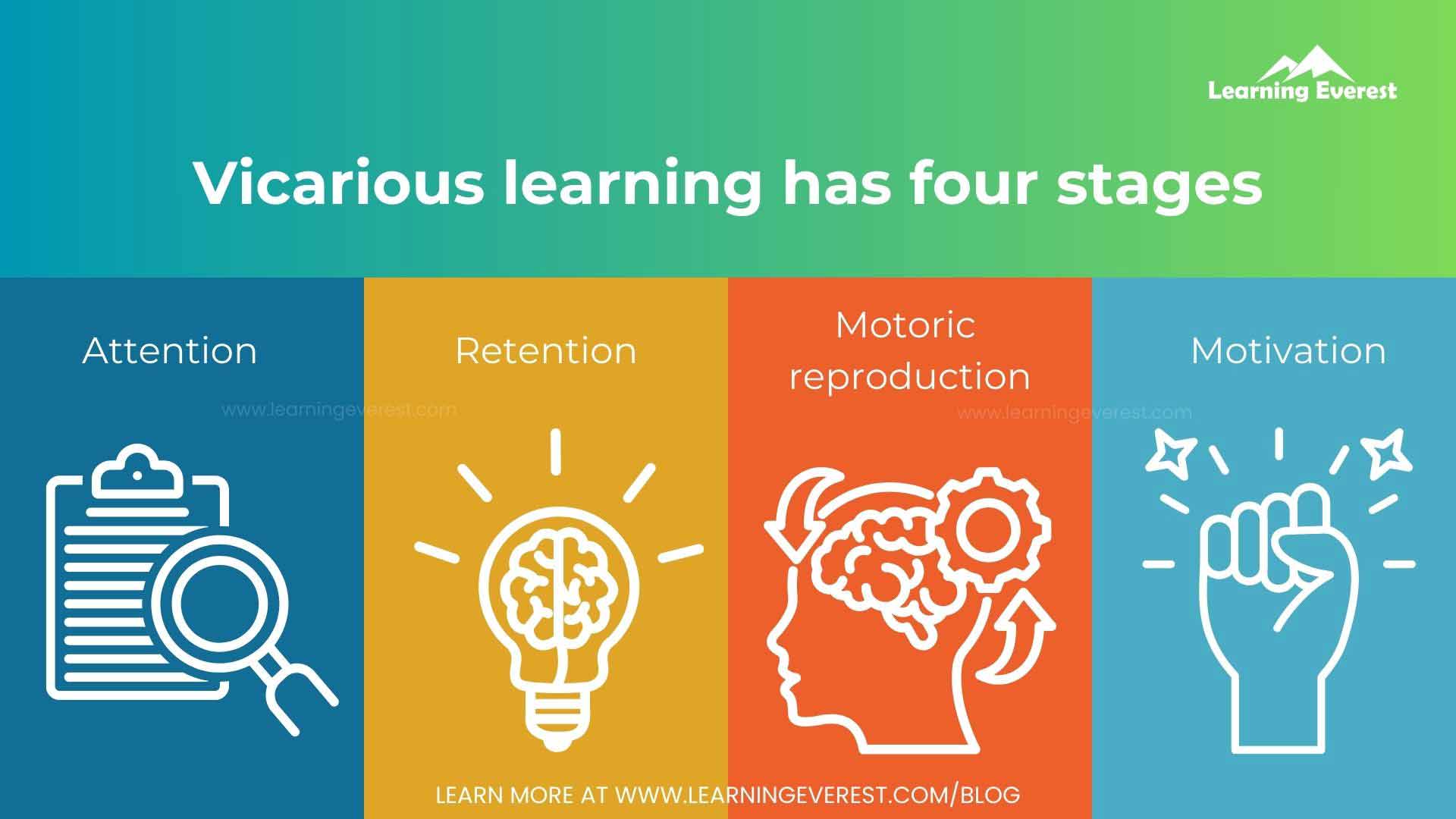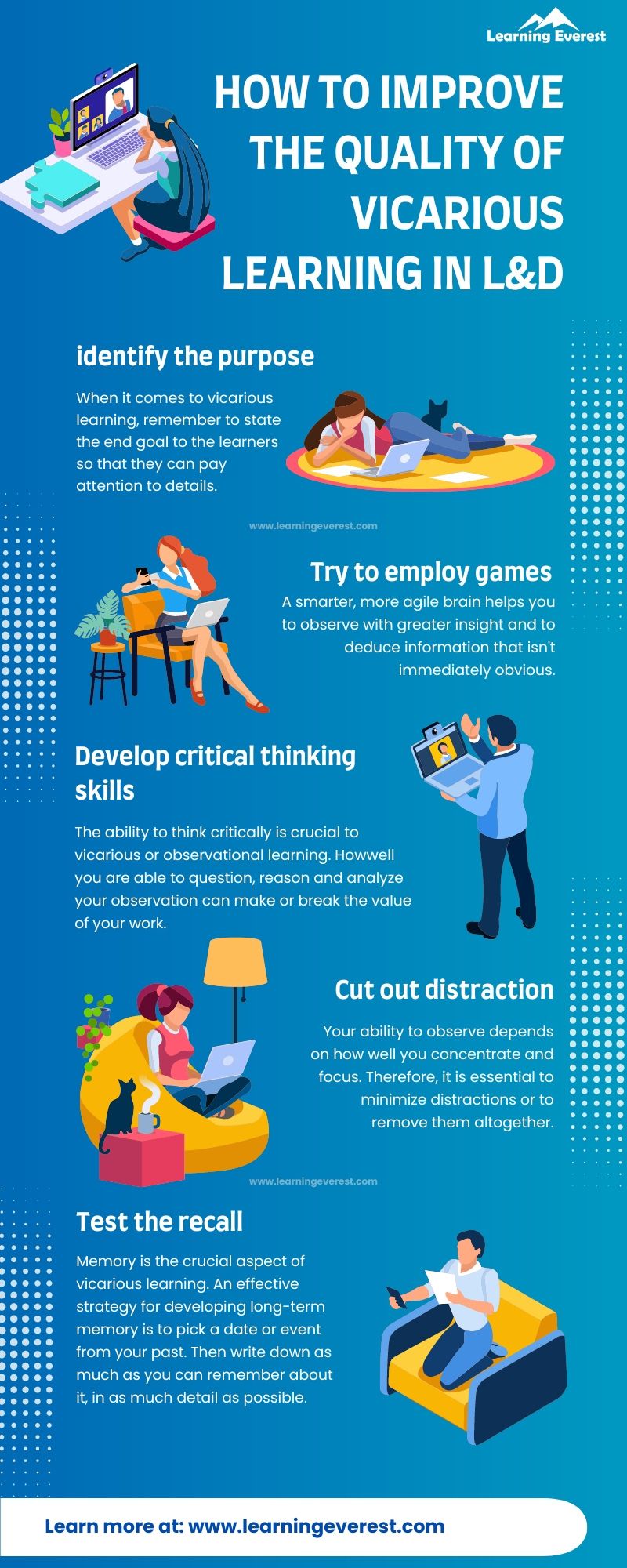Have you ever watched a video on YouTube to learn how to do something? Although not everyone is familiar with it by name, we all have experience with vicarious learning. Learning new things by watching others do something.
Let’s dive in!
Table of Contents
What is Vicarious Learning?
Vicarious learning is learning by observing the experiences of others without performing them directly. Humans can learn new behavior by direct experience or observing others’ behavior and consequences.
Babies learn by mimicking their parents. Toddlers learn to talk from hearing conversations. We adopt complex behavior and views, such as social etiquette or gender roles, because “this is what others normally do.”
This kind of learning experience is called vicarious learning, also known as observational and imitative learning. In vicarious learning, the learner attentively observes the actions of others, retains, and then mimics them.
In the 1960s, Canadian-American psychologist Albert Bandura did a series of experiments to acknowledge whether social behaviors could be accrued by observation and imitation. The experiments were collectively known as the Bobo doll experiments.
Through research, he found that the group of people that observed aggressive behavior being rewarded later behaved aggressively more than the group that observed aggression being punished. The children’s behavior was vicariously reinforced despite not being directly rewarded or punished.
This is called vicarious conditioning.
Therefore, observational learning can be reinforced through vicarious reinforcement.
Backed by his conclusions in the Bobo doll experiments, Albert Bandura developed the social learning theory in 1977. The idea later evolved into the social cognitive theory in 1986, which hypothesizes that learning takes place in a social environment with an ever-changing and shared interaction between person, environment, and behavior.
Also read: Implications of Bandura’s Social Learning Theory
The Importance of Vicarious Learning
Learning without direct interaction allows knowledge transfer without tedious trial and error. It can ensure learning without directly experiencing danger. This kind of learning passes on a community’s beliefs, traditions, etiquette, and norms. Formal learning can happen through the vicarious experience without actual social learning situations.
How does Vicarious Learning Happen?

Vicarious Learning has Four Stages
Despite having simple titles such as imitation, copying, and matching, Bandura’s Social Cognitive Theory suggests that it is a complex procedure involving biological and mental factors.
Biologically, mirror neurons, a particular type of brain cells that tell us to mimic others, are vicariously activated by observing others with vision or sound. The theory suggests that people can learn through observing. Learners can educate themselves by directly observing the behaviors of others and by following the consequences of using those behaviors. There are four stages of it:
1. Attention
Cognitively, the first stage in vicarious learning is paying attention. People do not learn all the behaviors that they watch. A mere exposure does not mean that a person will pay close attention to it, pick the most relevant characteristics, and perceive those aspects accurately. If a person fails to recognize and relate to the essential features of the model’s behavior, they cannot learn much from the vicarious observation.
Identification plays a vital role in this process. People are likely to pay attention and mimic the observed behavior of someone to whom they can identify and relate, as we can see peer learning in our daily lives. For instance, employees are more likely to impersonate their peers than historical role models or leaders they read about.
2. Retention
After seeing it, a person needs to be able to remember the observed learning. A symbolic form of the behavior must be present for them to reproduce such behavior. People who mentally rehearse or perform the observed behavior are more likely to retain the information.
3. Motoric reproduction
After paying attention and retaining the observed behaviors, an individual must coordinate different actions in the correct order to perform them physically and make adjustments based on the feedback.
4. Reinforcement and motivation
Finally, to activate the observed learning, a person must be driven to repeat the behavior. The similarity of the model influences motivation to repeat a behavior pattern, the observer’s perception of their physical abilities, and the perceived rewards and punishments associated with it.
Now that you know the stages of how vicarious learning takes place, let us examine their applications in detail. So, if you are wondering how to use vicarious learning theory in workplace training, keep reading!

Vicarious Learning
Vicarious Learning Examples
Here are some examples of how you can deploy vicarious learning in workplace training:
1. Video tutorials
You can learn everyday tasks be it baking a cake or restoring your backyard deck, from demonstration videos on platforms like YouTube, Vimeo, and Udemy. Video tutorials provide learners with instructions and demonstrations on how to do these hands-on tasks in similar situations. People with visual learning styles, who have grown up watching video content more than reading books, benefit most from these types of learning. This can be achieved using animated videos as well. The visuals quickly capture the learner’s attention and can easily communicate the training goals.
2. Mentorship
This provides a unique learning opportunity for learners to learn without traditional classrooms. Here, they learn about their thought processes and mistakes without making the same mistakes themselves.
3. Scenario-based learning
A scenario-based learning program offers the learners a scenario or a situation and is then asked how to go forward in that given scenario. This type of learning is based on the principles of situated learning theory formulated by Lathe and Vendor in 1991. As per them, they are learning best takes place in the context in which it will be used. Scenario-based learning creates a safe environment where learners can interact socially.
A scenario-based learning environment eliminates the lack of personal one-on-one engagement with instructors by providing an interactive environment for active learning. This type of learning aims to identify a solution or response to a real-life issue. Through scenario-based learning, it is possible to provide compliance training, soft skills training, professional skills training, leadership training, etc.
4. Gamified learning
Gamification in training is the process of adding competitive game-based elements to training programs to create an engaging training environment while also increasing knowledge retention. Organizations often apply gamification to employee training, recruitment, evaluation, and organizational productivity. When your organization implements gamification, you will get more than just increased user engagement. Successful gamification will tap into the employees’ intrinsic motivation, such as becoming more skilled at their job, while offering extrinsic motivation, such as rewards, points, and badges.
5. Modelling
Facilitators should expose learners to various models essential to break down stereotypes. Modeling provides an alternative to teaching new behaviors. Instead of using shaping and operant conditioning, modeling is a faster, more efficient means of teaching. To promote effective modeling, facilitators must ensure the four necessary conditions exist with observation: attention, retention, motor reproduction, and motivation.
6. Webinars
Webinars are live or recorded online presentations that employees can watch at their convenience. It is a type of asynchronous learning. Employees can repeat past sessions they need to brush up on at any time, which is impossible with synchronous learning methods. This is a huge advantage for the employees. This allows employees to remember and relearn the materials at their convenience.
7. Assign social learning buddies
Learners tend to perform better when paired with a learning buddy. Assigning social learning buddies will help learners by facilitating collaboration, fostering team skills, enabling expertise sharing, and also building confidence. Creating social media groups for knowledge sharing can be an effective way to do this. Learners can use Facebook, Twitter, or LinkedIn to share their progress or certificate.
Moreover, learners must believe that they can accomplish a task; it is essential to develop a sense of self-confidence for learners. Facilitators can promote such self-confidence by providing learners receive confidence-building messages, watch others succeed, and also experience success independently. Facilitators should support them in creating demanding yet reasonable expectations.
Key Benefits of Deploying Vicarious Learning in eLearning
At this time, it is essential to note that vicarious learning provides an added advantage to simple observational learning. Vicarious learning places criticality on the capability of the learner to visualize themselves doing the said activity while understanding the right action through observation. When this visualization is acquired, it creates a long-lasting impact on the learner and leads to knowledge retention and practical application.
- Ease in implementation: Compared to traditional training programs, it is easier to implement vicarious learning in the workplace. The trainees can easily observe, learn, and visualize the scenario for their understanding. Moreover, clarifications and support can be easily provided immediately. There is no time lost, and it gets the job done effectively.
- Risk-free application: Vicarious learning offers a safe space for practice. It gives the learner ample opportunities to practice the newly acquired knowledge and improve further along the way without the risk of failure or dire consequences as in a real environment. It boosts confidence and pushes them to excel.
- Learning flexibility: Learners can observe, visualize, and learn at their own pace. Since communication is in tandem, there is always an exchange of ideas, information, and troubleshooting. The flexibility in learning leads the way for long-term retention and sustained improvement.
Infographic
Knowledge check!
Let us look at some FAQs to better understand vicarious learning in organizational L&D.
Frequently Asked Questions (FAQs)
1. What is the difference between vicarious and observational learning?
Observational learning is the way of learning by watching others, who are called models. Observational learning is called “vicarious conditioning” because it involves learning by watching others acquire responses through classical or operant conditioning.
2. What training opportunities warrant vicarious learning at the workplace?
As explained about the concept through the course of this blog, enterprises have an array of opportunities for implementation. The ideal opportunities are customer support or customer experience skills, sales negotiations, communicating with clients, troubleshooting instances, and more.
Does your organization use vicarious learning to foster collaboration? Or would you like to understand how this would work for your organization?
To learn more, BOOK A DEMO TODAY!
The following article can also be a useful guide as you get started:






